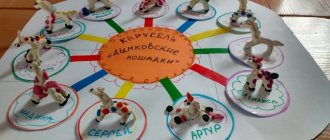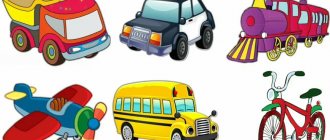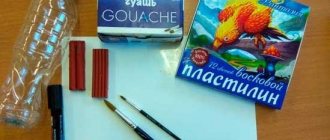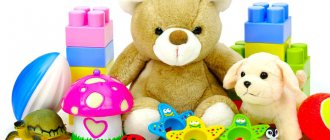Project in the middle group “Russian folk toy”
Form a problem using a system of 3 questions:- What do we know about Dymkovo toys?
- What do we want to know about Dymkovo toys?
- Where and how can we find answers to our questions?
The three-question system identified the following research questions:
— Where did the name “Dymkovo Toy” come from?
— What colors do the masters use?
— What elements are the products painted with?
Relevance: Nowadays, little attention is paid to introducing children to various types of arts and crafts and folk traditions. The conditions for introducing children to folk art using, for example, the Dymkovo folk toy are not sufficiently formed. But it is decorative drawing classes that can teach children to perceive the beautiful and the good, and teach them to admire beauty.
The goal of the project: to develop in children a cognitive and creative interest in Russian folk culture, through familiarization with the Dymkovo toy, and the organization of artistic, productive and creative activities.
Project objectives:
— Introduce children to the history of the Dymkovo toy.
— Develop the ability to draw the simplest elements.
— Develop color perception, sense of rhythm, creative imagination.
— Develop the ability to create patterns.
— Cultivate interest in arts and crafts.
Collecting information about questions that interest us about the Dymkovo toy from various sources.
- from the Internet
- from encyclopedias
- from conversations with parents
- from educational programs
-conversations and master classes with a fine arts teacher
-visit to the “Russian Hut”, stories from the Hostess
Cognitive and speech development
— Examination of illustrations and products of Dymkovo masters.
— Conversations: “Introduction to the Dymkovo toy,” “In the world of the Dymkovo toy.”
“What are Dymkovo toys made of?”
— Reading fiction: poems, Russian nursery rhymes about Dymka,” “Merry Dymka” by A. Dyakov, “What is Dymkovo famous for?” V. Feofanov, “Toy ditties” by P. Sinyavsky.
— Acquaintance with oral folk art (songs, nursery rhymes, poems, fables, proverbs, sayings, jokes, riddles).
— Use of fiction (reading Russian folk tales).
— Compiling stories from children’s personal experiences “My favorite toy.”
— Acquaintance with the history of the emergence of the Dymkovka fishery.
Social and communicative development
— C\r game: “Family”
— Mummering corner (sundresses with elements of a smoky pattern and a crown - transformation into Dymkovo young ladies).
Visual activities
—Drawing: “Dymkovo patterns”, “Magic horses”, “Fairytale ram”,
— Modeling: “Ram with golden horns”
Outdoor games: Folk games: “At the bear in the forest”; "Swan geese"; "The Kite and the Chickens" "Golden Gate".
— Round dance games: “Loaf”.
Didactic games:
— Didactic games: “Decorate the Dymkovo horse”, “Find the same pattern”, cut-out pictures on the theme: “Dymkovo toys”, “The beauty of the Dymkovo ornament”, “Dymkovo mosaic”, “Make a pattern”, “What has changed”.
Joint event with preparatory group No. 11: “Excursion to a mini-museum”
Project results:
90% of the group's students participate in the project. In the process of implementing this project, the students became more familiar with the oldest craft in Russia - the Dymkovo toy; with the history of its appearance in Rus'; with the types and variety of Dymkovo toys, elements of the painting pattern. In the process of making Dymkovo toys, the children not only continued their acquaintance with Russian folk toys, but also received positive emotions, and the production of works for the exhibition “Dymkovo Toy” brought parents and children even closer together. Children can distinguish Dymkovo toys from toys of other masters. As a result of the project, children developed a strong interest in folk crafts. Children have mastered the colors of this painting, can name all the elements, learned drawing techniques and learned how to make patterns on various shapes. The guys received positive emotions when meeting the beautiful things.
MAGAZINE Preschooler.RF
Educational project "RUSSIAN FOLK TOY" Middle groupHello, I would like to publish my project dedicated to Russian folk toys.
It all started when I came across a book about a Russian folk rag doll. I wanted to tell the guys about these wonderful dolls. But if we talk about dolls, then we need to talk about other folk toys. The result was a whole project: we painted; sculpted; played with Russian folk toys; learned nursery rhymes, fables, lullabies; staged them; played Russian folk games; made a Pelenashka doll with our own hands. Our parents also helped us. They participated in the family living room, in organizing the exhibition “Toys of Our Grandmothers” . I have attached the text of the project and a photo to it to the letter.
Sincerely, Olga Sergeevna Astakhova, teacher, GBOU School No. 947 Moscow 2015
Project Description
Relevance of the project:
A modern child is focused on toys from Western countries and does not have sufficient information about traditional folk toys. Therefore, given the importance of toys for both children and adults, it is necessary to introduce children to folk toys, which will help to introduce them in the future to the national culture of Russia. The relevance of the project lies in the return of the younger generation to Russian national traditions, to the study of historical roots.
Our project will allow:
- to generate interest in folk toys, folk arts and crafts, master the art of making toys with your own hands, elements of painting;
- instill respect for Russian history;
- replenish the subject development environment;
- put a piece of your soul into a toy, become masters.
Project goal: To introduce children to folk culture through familiarization with folk toys.
Project objectives:
- Introduce children to the variety of folk toys (clay, wood, rag, straw, etc.), with the characteristic features of different crafts.
- To form an aesthetic attitude towards objects of art, to teach them to see their beauty and originality.
- Instill respect for the culture of your people.
- To develop communication skills in children: communication and interaction with adults and peers, emotional responsiveness, empathy, and a friendly attitude towards others.
- Enrich children's vocabulary, introduce new words and their meanings.
- Create a desire to create something beautiful with your own hands.
- To foster a value-based attitude towards family traditions and the joint work of adults and children.
Project type:
Composition: group
Duration: medium-term (1 month)
The participants of the project are middle preschoolers, teachers of the institution, and parents.
Nature of the subject area: cognitive development
Integration of areas: cognitive development, social and communicative development, artistic and aesthetic development, speech development, physical development.
Project implementation stages:
- 1. Preparatory
- 2. Main
- 3. Final
Estimated outcome of the project:
- nurturing a love for Russian folk art
- a child is a creator, master, creator of a folk toy
- the child knows how to collaborate in a team
The expected product of the project: dolls made by hand, an open lesson “Visiting the hostess” .
Project implementation scheme
Preparatory stage
- Setting goals, determining the relevance and significance of the project.
- Selection of methodological literature for the implementation of the project (magazines, articles, abstracts, etc.).
- Selection of visual and didactic material; fiction; didactic games, development of conversations, development of activities
- Development of consultation for parents.
- Organization of a developmental environment in a group
| Next > |






